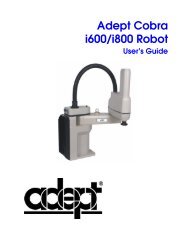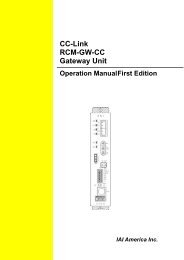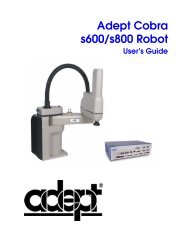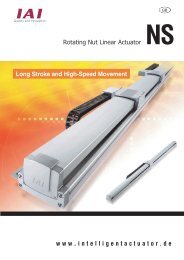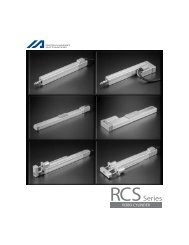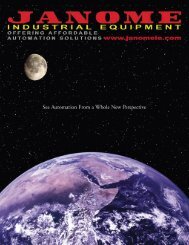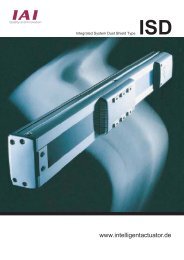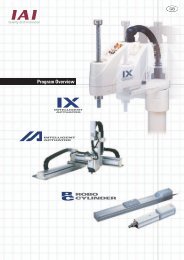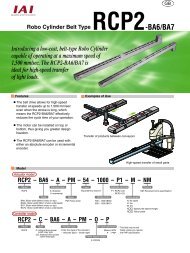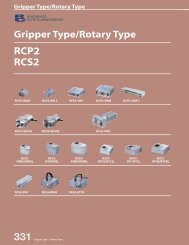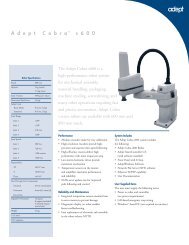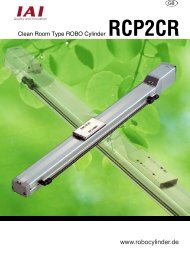Download Adept Cobra PLC600 User's Guide - pulsar.com.tr
Download Adept Cobra PLC600 User's Guide - pulsar.com.tr
Download Adept Cobra PLC600 User's Guide - pulsar.com.tr
You also want an ePaper? Increase the reach of your titles
YUMPU automatically turns print PDFs into web optimized ePapers that Google loves.
Robot Concepts<br />
Breaking Continuous-Path Operation<br />
The “basic” method of moving the robot (see page 82) causes program execution to be<br />
suspended until the current robot motion reaches its destination location and <s<strong>tr</strong>ong>com</s<strong>tr</strong>ong>es to a<br />
stop. This is called breaking continuous path. This method is useful when the robot must<br />
be stopped while some operation is performed (for example, closing the gripper or<br />
applying a dot of adhesive).<br />
Joint-Interpolated Motion vs. S<strong>tr</strong>aight-Line Motion<br />
The path a motion device takes when moving from one location to another can be either a<br />
joint-interpolated motion or a s<strong>tr</strong>aight-line motion. A joint-interpolated motion moves<br />
each joint at a constant speed (except during the acceleration/deceleration phases-see<br />
“Speed, Acceleration, and Deceleration” on page 137). With a rotationally-jointed robot,<br />
the robot tool tip typically moves along a curved path during a joint-interpolated motion.<br />
Although such motions can be performed at maximum speed, the nature of the path can<br />
be undesirable.<br />
S<strong>tr</strong>aight-line motions ensure that the robot tool tip <strong>tr</strong>aces a s<strong>tr</strong>aight line. That is useful for<br />
cutting a s<strong>tr</strong>aight line, or laying a bead of sealant, or any other situation where a totally<br />
predictable path is desired.<br />
NOTE: For X, XY, XYZ, or XYZT devices, s<strong>tr</strong>aight-line motion and<br />
joint-interpolated motion result in identical paths, because the<br />
(positioning) joints all move in s<strong>tr</strong>aight lines themselves.<br />
When bit N240:3/9 or <s<strong>tr</strong>ong>Adept</s<strong>tr</strong>ong>_Motion_Qualifier.9 is OFF, the robot uses joint-interpolated<br />
motion; when that bit is ON, the robot uses s<strong>tr</strong>aight-line motion.<br />
Performance Considerations<br />
Things that may impact performance in most applications include robot mounting, cell<br />
layout, part handling, and programming approaches.<br />
Robot Mounting Considerations<br />
The mounting surface should be smooth, flat and rigid. Vibration and flexing will affect<br />
performance. It is re<s<strong>tr</strong>ong>com</s<strong>tr</strong>ong>mended that a minimum 25mm (1 inch) steel plate with a rigid<br />
tube frame be used. When positioning a robot in the workcell, take advantage of moving<br />
multiple joints for faster motions. On a SCARA robot, the “Z” and “theta” axes are the<br />
slowest, and motion of these joints should be minimized whenever possible. This can be<br />
ac<s<strong>tr</strong>ong>com</s<strong>tr</strong>ong>plished by positioning the robot, and setting conveyor heights and pick and place<br />
locations, to minimize Z-axis motion.<br />
Cell Layout Considerations<br />
Regarding cell layout and jointed arms, the same point-to-point distance can result in<br />
different cycle times. Moving multiple joints <s<strong>tr</strong>ong>com</s<strong>tr</strong>ong>bines the joint speeds for faster motion.<br />
If the same distance is <strong>tr</strong>aversed using motion of a single joint, the motion of that joint will<br />
be longer, and therefore will take more time.<br />
140 <s<strong>tr</strong>ong>Adept</s<strong>tr</strong>ong> <s<strong>tr</strong>ong>Cobra</s<strong>tr</strong>ong> <s<strong>tr</strong>ong>PLC600</s<strong>tr</strong>ong>/PLC800 Robot User’s <s<strong>tr</strong>ong>Guide</s<strong>tr</strong>ong>, Rev B



